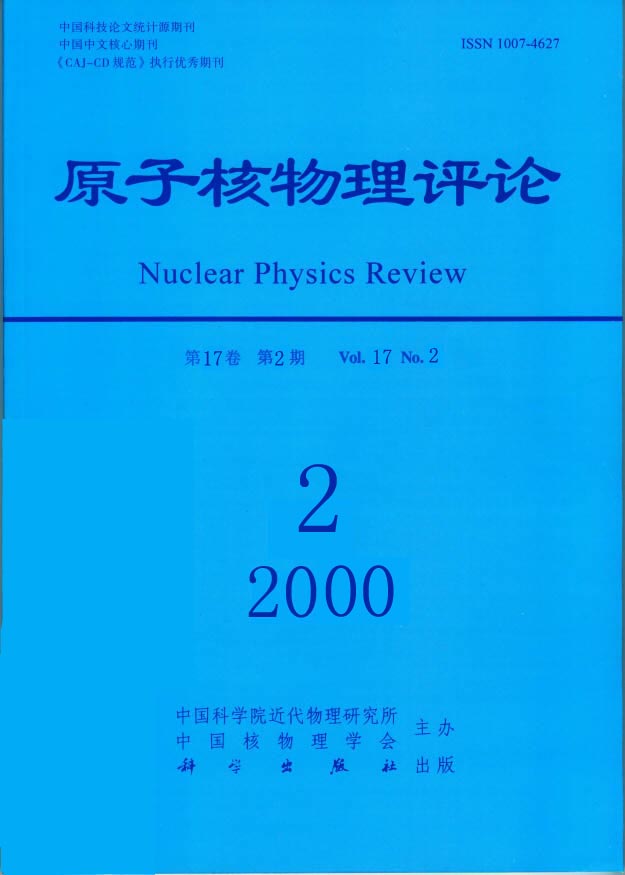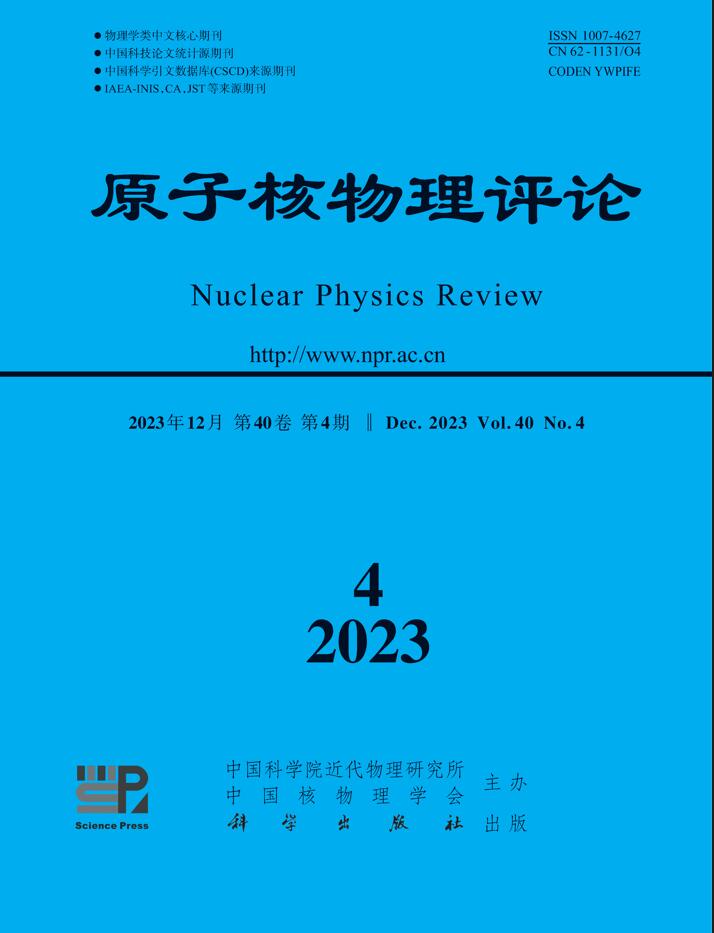2000 Vol. 17, No. 2

Display Method:
2000, 17(2): 63-71.
doi: 10.11804/NuclPhysRev.17.02.063
Abstract:
Nucleon nucleon interaction is the key point of nuclear physics, bridging the gap between QCD and the effective interaction appropriate for nuclear many body calculations. The older potential models are no longer suitable for describing the present set of more numerous and much more accurate experimental data without refitting the parameters. In 1990s, both older (classical) phenomenological potentials and meson exchange potentials have already had ...
Nucleon nucleon interaction is the key point of nuclear physics, bridging the gap between QCD and the effective interaction appropriate for nuclear many body calculations. The older potential models are no longer suitable for describing the present set of more numerous and much more accurate experimental data without refitting the parameters. In 1990s, both older (classical) phenomenological potentials and meson exchange potentials have already had ...
2000, 17(2): 72-76.
doi: 10.11804/NuclPhysRev.17.02.072
Abstract:
The energy straggling of 2.0~5.4 MeV carbon ions in aluminum films evaporated onto K4 glass substrates was measured with the Au marked RBS method. The surface roughness with zero was obtained from experiment. It supplied a method for determination of the surface roughness with zero. The present result was compared with the Bohr theory and the results of published experimental work It is shown that the Bohr theory is not appropriate to description of the energy straggling of low energy ...
The energy straggling of 2.0~5.4 MeV carbon ions in aluminum films evaporated onto K4 glass substrates was measured with the Au marked RBS method. The surface roughness with zero was obtained from experiment. It supplied a method for determination of the surface roughness with zero. The present result was compared with the Bohr theory and the results of published experimental work It is shown that the Bohr theory is not appropriate to description of the energy straggling of low energy ...
2000, 17(2): 77-81.
doi: 10.11804/NuclPhysRev.17.02.077
Abstract:
HJ4/9] By systematic study of the IMF produced the “neck”emission process, one can understand much better about the dynamics and thermodymanics of the intermediate energy nuclear reaction. The isospin dependence of IMF emission was studied for the reaction system with different isospin target nucleus and the different IMF production mechanisms that originate from projectile like、 target like and the “neck” were distinguished.
HJ4/9] By systematic study of the IMF produced the “neck”emission process, one can understand much better about the dynamics and thermodymanics of the intermediate energy nuclear reaction. The isospin dependence of IMF emission was studied for the reaction system with different isospin target nucleus and the different IMF production mechanisms that originate from projectile like、 target like and the “neck” were distinguished.
2000, 17(2): 82-86.
doi: 10.11804/NuclPhysRev.17.02.082
Abstract:
The new progress of proton halo researches in theory and experiment was introduced. Especially the structure of halo nuclei having 2s1d shell and the different models predicting the existence of proton halos in 26~28 P, 27~29 S were discussed. A recent experiment proving the existence of one proton halo in 26~28 P was reviewed and finally the conditions forming proton halo were discussed briefly.
The new progress of proton halo researches in theory and experiment was introduced. Especially the structure of halo nuclei having 2s1d shell and the different models predicting the existence of proton halos in 26~28 P, 27~29 S were discussed. A recent experiment proving the existence of one proton halo in 26~28 P was reviewed and finally the conditions forming proton halo were discussed briefly.
2000, 17(2): 87-90.
doi: 10.11804/NuclPhysRev.17.02.087
Abstract:
The physical motivations with high spin isomer beams were introduced. Taking HSIB of RIKEN as an example, the methods to produce, separate, transport and purify high spin isomer beams were described briefly, and the detection of γ rays emitted from the reactions induced by the high spin isomer beams was presented. Finally, the progress to develope the high spin isomers in the N =83 isotones as second beams was stressed.
The physical motivations with high spin isomer beams were introduced. Taking HSIB of RIKEN as an example, the methods to produce, separate, transport and purify high spin isomer beams were described briefly, and the detection of γ rays emitted from the reactions induced by the high spin isomer beams was presented. Finally, the progress to develope the high spin isomers in the N =83 isotones as second beams was stressed.
2000, 17(2): 91-94.
doi: 10.11804/NuclPhysRev.17.02.091
Abstract:
The test of part benchmark of SHIELD code was performed. The cross section, mass distribution and excitation function of the fragments (including residual nuclei) in the proton induced spallation reaction on thin Pb target at intermediate energy have been calculated by SHIELD code. And the results are in good agreement with experimental data. The fragment mass distributions from proton induced spallation reaction on thick Pb traget at incident energy 1.6 GeV were also presented.
The test of part benchmark of SHIELD code was performed. The cross section, mass distribution and excitation function of the fragments (including residual nuclei) in the proton induced spallation reaction on thin Pb target at intermediate energy have been calculated by SHIELD code. And the results are in good agreement with experimental data. The fragment mass distributions from proton induced spallation reaction on thick Pb traget at incident energy 1.6 GeV were also presented.
2000, 17(2): 95-99.
doi: 10.11804/NuclPhysRev.17.02.095
Abstract:
From the viewpoints of the HIRFL operation and the new requirements to HIRFL by the study of radioactive beam physics and CSR project, the HIRFL upgrading program has been proposed after studying the existing problems found during the operation and new problems when increasing the beam intensιty and ion variety. The accelerator physics problems of the upgrading program were discussed here, which include the space charge effect on the very low energy beam line...
From the viewpoints of the HIRFL operation and the new requirements to HIRFL by the study of radioactive beam physics and CSR project, the HIRFL upgrading program has been proposed after studying the existing problems found during the operation and new problems when increasing the beam intensιty and ion variety. The accelerator physics problems of the upgrading program were discussed here, which include the space charge effect on the very low energy beam line...
2000, 17(2): 100-105.
doi: 10.11804/NuclPhysRev.17.02.100
Abstract:
As swift heavy ions are available for irradiation damage study, it has been tried to evidence whether electronic energy loss might play a role in the damage processes of metallic targets. Experimental investigations showed that, as increase of electronic energy loss, large amount of electronic energy loss can result in radiation annealing of part of defects produced by elastic collisions, defect creation, latent track formation, as well as phase transition, and so on. Pure metals...
As swift heavy ions are available for irradiation damage study, it has been tried to evidence whether electronic energy loss might play a role in the damage processes of metallic targets. Experimental investigations showed that, as increase of electronic energy loss, large amount of electronic energy loss can result in radiation annealing of part of defects produced by elastic collisions, defect creation, latent track formation, as well as phase transition, and so on. Pure metals...
2000, 17(2): 106-109.
doi: 10.11804/NuclPhysRev.17.02.106
Abstract:
There are three non destructive radiological methods for identitication of warfare agents and TNT. Their principles and problems related were discussed. Portable isotopic neutron spectroscopy is based on the assay of key elemental composition (such as Cl, P, H, As, S, N) in chemical agents by neutron induced prompt gamma ray analysis. Hydrogen concentration measurement by means of using thermal neutron can be exployed to identify chemical warfare agents and TNT...
There are three non destructive radiological methods for identitication of warfare agents and TNT. Their principles and problems related were discussed. Portable isotopic neutron spectroscopy is based on the assay of key elemental composition (such as Cl, P, H, As, S, N) in chemical agents by neutron induced prompt gamma ray analysis. Hydrogen concentration measurement by means of using thermal neutron can be exployed to identify chemical warfare agents and TNT...
2000, 17(2): 110-113.
doi: 10.11804/NuclPhysRev.17.02.110
Abstract:
The technique for detecting the delayed neutrons from neutron induced fission in uranium systems was studied by using an active method with 3He proportional counting tube array and a 14 MeV D T neutron source. Under the conditions of different shielding and combination, the distributions of delayed fission neutrons from depleted uranium systems were measured and the reliability of the systems was studied. The method to distinguish a nuclear system from a non nuclear one was discussed.
The technique for detecting the delayed neutrons from neutron induced fission in uranium systems was studied by using an active method with 3He proportional counting tube array and a 14 MeV D T neutron source. Under the conditions of different shielding and combination, the distributions of delayed fission neutrons from depleted uranium systems were measured and the reliability of the systems was studied. The method to distinguish a nuclear system from a non nuclear one was discussed.
2000, 17(2): 114-116.
doi: 10.11804/NuclPhysRev.17.02.114
Abstract:
Comparison on the nuclear explosive products ’ radioactivity, biological hazard potential, energy deposition after nuclear explosion between the model of 233 U and the model of weapon grade plutonium was made. The detail analysis of the process of above physics quantities in the model of weapon grade Plutonium was also given.
Comparison on the nuclear explosive products ’ radioactivity, biological hazard potential, energy deposition after nuclear explosion between the model of 233 U and the model of weapon grade plutonium was made. The detail analysis of the process of above physics quantities in the model of weapon grade Plutonium was also given.
2000, 17(2): 117-120.
doi: 10.11804/NuclPhysRev.17.02.117
Abstract:
A novel and compact slow positron beam line——Beijing Slow Positron Beam Line was described. The basic physical concepts of the slow positron beam and its applications were reviewed. Recent experimental results showed the converting effcicency for the total positrons from the radioisotope to slow positrons was 8×10 -5 and the moderation efficiency was 1.7×10 -4 . The future development of Beijing Intense Slow Positron Beam, based on the BEPC LINAC, was also briefly discussed.
A novel and compact slow positron beam line——Beijing Slow Positron Beam Line was described. The basic physical concepts of the slow positron beam and its applications were reviewed. Recent experimental results showed the converting effcicency for the total positrons from the radioisotope to slow positrons was 8×10 -5 and the moderation efficiency was 1.7×10 -4 . The future development of Beijing Intense Slow Positron Beam, based on the BEPC LINAC, was also briefly discussed.
2000, 17(2): 121-126.
doi: 10.11804/NuclPhysRev.17.02.121
Abstract:
A 1.3 GHz photocathode RF gun is under study in peking University. The photocathode RF gun, composed of gun cavity, photocathode and Laser system, is expected to deliver a electron beam with a normalized transverse rms emittance of 1π mm·mrad at a charge of 1nC. Its performance has been studied by the space-charge tracking code PARMELA. The influences of the initialized electron beam were also studied. The emittance compensation technique is employed. After optimization of the parameters was...
A 1.3 GHz photocathode RF gun is under study in peking University. The photocathode RF gun, composed of gun cavity, photocathode and Laser system, is expected to deliver a electron beam with a normalized transverse rms emittance of 1π mm·mrad at a charge of 1nC. Its performance has been studied by the space-charge tracking code PARMELA. The influences of the initialized electron beam were also studied. The emittance compensation technique is employed. After optimization of the parameters was...







 甘公网安备 62010202000723号
甘公网安备 62010202000723号